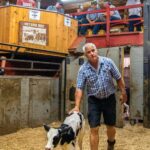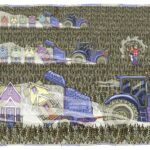

left to right: Jo-Anne Tabobandung’s cohort in 1990; Jo-Anne Tabobandung, Dean of Aviation Technology Program; Flight instructor Joshua Bisson with student

left to right: Zoie Michelin standing with the aircraft she operates with Air Borealis, the Twin Otter(DHC6) in Happy Valley-Goose Bay, Labrador; Former elected chief, Earl Hill (right), and councillor Doug Maracle (left) circa 1990.
Indigenous student pilots in Tyendinaga are slipping the surly bonds of earth and blazing new paths through the skies.
Flying above the rugged coast of Nunatsiavut along the Labrador Sea, Zoie Michelin took in the landscape surrounding her: mountains and hills, water so vividly blue and beautiful she could hardly describe it, the presence of her ancestors following along the wind.
The flight that took her above Northern Labrador to Torngat Mountains National Park wasn’t her first as a pilot, but it was her most memorable. From the air she could see the community her grandmother was from as she followed the path of her grandparents’ love story from the sky. “My grandfather travelled to my grandmother’s community by dog team to marry her. I had this amazing opportunity because I am a pilot and there’s so much history in these lands.”
Michelin, an Inuk woman from North West River Labrador with roots in Nunatsiavut, knew from the moment she applied to the Aviation Technology Program at the First Nations Technical Institute (FNTI) in Tyendinaga Mohawk Territory, that she would eventually return home to use her skills serving her own community. The three-year advanced program provides hands-on flight training for Indigenous students interested in pursuing a pilot’s licence or working in the aviation industry.
“A lot of our graduates are back in their communities doing medivac flights, transporting seasonal workers and cargo, all of the essential services that the communities need,” says Jo-Anne Tabobandung, Dean of Aviation at FNTI, the only post-secondary Indigenous aviation program of its kind in the country. Many of the school’s graduates are working at Indigenous-owned and regional airlines such as Air Creebec, a northern airline based in Quebec, and Missinippi Airways, which serves First Nations communities in Northern Manitoba and beyond.
While graduates of mainstream aviation programs in Ontario may choose to go to smaller centres just to get their flying hours, many of FNTI’s graduates hope to serve in their own communities. “Their main goal is to go back to these communities … and then to go on to become role models. When one of our students graduates, it affects them, their family, their extended family, their community and their nation.”
The program at FNTI is more important than ever as the shortage of pilots and aerospace workers in Canada becomes critical. In 2018 The Canadian Council for Aviation and Aerospace (CCAA) released a report predicting the industry will need an additional 7,300 pilots by 2025.
The CCAA reports that fewer than 1,200 new commercial pilot licences are issued each year in Canada, and in 2016 almost half of these were issued to international students. Meanwhile there is a large pull for pilots to move outside of Canada, where many positions pay more than local airlines can offer.
Many graduates of FNTI’s program plan to move to a northern or regional airline. “I knew I wanted to come back to my area, to help my fellow Inuit and to experience the beauty of the Twin Otter,” says Michelin. The Twin Otter aircraft, which seats 19 passengers, is designed to use the shorter unpaved airstrips common to remote areas, and can be converted so it can land on snow or water.
Michelin says coming to work on her homelands has been a joyful experience filled with learning opportunities in a tight-knit community. “I get to see the passengers board the plane, and when they get to their destination, you see their genuine smiles and connections with the people they love and the homes they go back to.”
Since graduating in 2021, Michelin has flown medivac (medical evacuation), cargo, passengers, supplies, and most recently she’s been chartered to fly for scientific surveying of whale populations throughout the region.
She also made history in 2022 as part of the first all-Indigenous female flight crew to fly at Air Borealis with Kayla Torarak, another Inuk pilot from Nunatsiavut. Torarak is also an alumna of FNTI’s flight school. “I’m glad we, as friends, got to make history within the company and within Nunatsiavut.”
The airline industry is small, and even smaller for Indigenous pilots. “I know a handful of pilots who are Indigenous and attended FNTI, and now they’re working here and spreading their knowledge and contributing to our communities. It’s really inspiring.”
FNTI sees enrollment from far beyond Tyendinaga Mohawk Territory – from coast to coast to coast, reaching First Nations, as well as Métis, Inuit and urban Indigenous communities across Canada.
LEADERSHIP FROM WITHIN | You can’t get into FNTI’s aviation building without walking by boards displaying student accomplishments: men and women smiling beside planes, often flanked by instructors, the occasional thumbs-up thrown into the air celebrating their first solo flights. Down a long narrow hallway you’ll find Dean Tabobandung’s office, where she sits comfortably, at ease with herself and her surroundings, which is no surprise as she first came to the school over 30 years ago. Her office has a wall of windows overlooking the runway, with photographs, news articles, and awards decorating the other walls and shelves. She meets guests at a small wooden table with a red cloth in the centre with sacred medicines on it.
Tabobandung was a 2021 recipient of the Northern Lights Aero Foundation’s “Elsie Award,” honouring women who have made outstanding contributions to aviation and aerospace. As well as being the dean, Tabobandung is a class one flight instructor, a pilot examiner, and a language assessor for Transport Canada, one of only 26 across the country.
A photo from the 1990s shows Tabobandung when she was the only woman in her aviation class. In another, she’s inspecting a plane – one hand up on the wing, one hand hanging down holding a dipstick for testing fuel, blonde hair, gold earrings, her oversized white button-down tucked into high-waisted jeans. On her first day there was a young man with a last name the instructor couldn’t pronounce. “I thought ‘imagine going through life with a name like that’,’” she says, laughing. She would later marry that classmate, from Wasauksing First Nation, and would take his last name, Tabobandung.
Tabobandung is Bear clan – both her parents are from Tyendinaga Mohawk Territory – but she grew up with her siblings in Toronto; the first time she lived in the community was when she moved into her grandparents’ old farmhouse to start flight school at FNTI in 1990. Her long history with the program includes not only meeting her husband Victor (now a pilot with Air Canada), but also later celebrating their wedding reception in FNTI’s historic World War II hangar, holding the role of chief flight instructor for 14 years, and even going into labour with her daughter while teaching ground school. Like Michelin, Tabobandung has found her way back to serving in her own community, although FNTI sees enrollment from far beyond Tyendinaga Mohawk Territory – from coast to coast to coast, reaching First Nations, as well as Métis, Inuit and urban Indigenous communities across Canada.
“Even on my days off, I was at FNTI. It just feels comfortable here. I think the Indigenous aspect really does take away a lot of the stress.” NAMAWIN (BRENDAN) PHILLIPS
Another photo Tabobandung has shows two men cutting a red ribbon in front of an airplane. The men are former Mohawks of the Bay of Quinte: elected chief Earl Hill and former councillor for the education portfolio, Doug Maracle. Both were strong supporters of FNTI and pushed to have the flight school opened.
“I would consider Earl Hill to be the founder of the aviation program. And his great-niece, Suzanne Katsi’tsiarihshion Brant, is our president right now,” says Tabobandung.
“Education was not always seen as a positive thing because of the residential schools and the impact they had on communities,” says Brant. “Earl felt that it was important that we educate our own people.”
Hill also recognized, from his experiences in Northern Ontario, that there was an absence of Indigenous pilots flying into remote areas. Despite facing adversity and pushback for their vision to create technology programs to support First Nations, the flight school began in 1989 at the Belleville airport, and moved to Tyendinaga in 1990.
As well as being the only Indigenous post-secondary aviation program of its kind in Canada, FNTI has an above-industry-level enrollment of women: 40 percent are women (the 2010 Human Resource Study of the Commercial Pilot in Canada reported the national average was just under five percent). The program creates an environment that is comfortable for Indigenous learners, including women, by cultivating a welcoming, culturally relevant, non-competitive atmosphere.
There are academic requirements for admission, but Tabobandung says the most important part of the application is the letter of intent. “Those stories are amazing. We have students who are the first people to have graduated high school in their families; we have letters from students who would ride their bike to the airport every Thursday, because that’s when the planes came in.”
A SENSE OF BELONGING | “I know if this school wasn’t here, I probably wouldn’t have made it through any kind of flight school and be a flight instructor right now,” says Daniella Pettiti. She graduated from the program in 2018 and came back as a flight instructor in 2021. What she found at FNTI wasn’t just an education, but a feeling of being accepted. Pettiti, who has roots in Waterhen Lake Cree Nation in Saskatchewan considers herself an urban Indigenous person, and says that she felt comfort seeing people who were like her in her classes.
Graduate and part-time flight instructor Namawin (Brendan) Phillips, who is from Hollow Water First Nation and grew up in Winnipeg, is a first officer (CRJ) with the regional airline, Jazz Aviation.
“Brendan was only 17 when we started school together, so he is like my little brother,” says Pettiti. Before taking the position with Jazz in 2022, Phillips worked as an FNTI flight instructor for four years. He recently returned to teaching part-time after missing his FNTI family.
“Even on my days off, I was at FNTI. I wasn’t working, but I was visiting, and always hanging out at lunchtime. It just feels comfortable here,” says Phillips. “I think the Indigenous aspect really does take away a lot of the stress.”
REBUILDING A COMMUNITY | The impact Tabobandung and the program have made in the aviation field could not have been more evident than when tragedy hit FNTI in February 2022. A hangar fire resulted in the loss of the structure, fleet of 13 planes, the aircraft maintenance organization and dispatch centre.
The students had just arrived back after a school shutdown due to Covid; a few nights later, Tabobandung received a phone call from one of the students saying that a fire had broken out. “Just driving in you could see the sky was orange,” she says. “Nobody was injured so we had to really take stock, not of what we lost, but what we have.”
The staff, students and aviation community immediately sprang into action. The fire happened on a Thursday, and by Monday they had a plan for all their students. Everyone from small Indigenous airlines to the largest airlines in the country reached out to help. Frontenac Aviation in Kingston offered an airplane for training and they leased two planes from Seneca College. Companies such as Air Canada, WestJet and Jazz helped to raise the funds needed for continued private pilot training for 13 students. FNTI struck agreements for flight training at seven different training units across the country.
“This was the worst-case scenario that could have ever happened here and we got through it, and we didn’t do it alone,” says Tabobandung. She predicts they will have their full fleet of planes and full complement of students by 2024.
“It would be nice if whatever is happening here at FNTI could be moved to other flight schools,” says Daniella Pettiti. “And then maybe we can change aviation from within.”
The FNTI Aviation Technology Program has created a supportive environment for learning and cultural exchange that is deeply rooted in Indigenous ways of knowing and being connected. The living, breathing heart of the program and the real-life way that it operates embody community, resiliency, relationship building, respect, treating everyone as equals – and doing it all while making a few jokes and pushing to create change for Indigenous people and communities.
“Everything that I do falls back on my background and my beliefs,” says Jo-Anne Tabobandung. “I’m inherently resilient. But I also honour my roles and responsibilities and value relationships.”
Story by:
Shelby Lisk
Photography by:
Shelby Lisk



